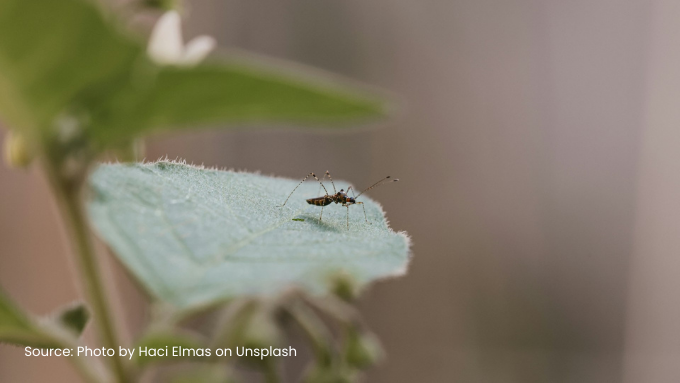Rainfall Pattern with Dengue Hemorrhagic Fever Incidence Rate in Blitar Regency

Downloads
Background: Dengue fever is a vector infectious disease with Aedes Aegypti mosquito as the main vector that can be found throughout Indonesia. Dengue Fever (DBD) is a health problem that exists in the world, especially in developing countries. Geographic, climatic, and population are factors that can influence the spread of vectors causing Dengue Dengue Dengue Fever disease.
Objective: The purpose of this writing is to find out the relationship between rainfall and dengue fever (DBD) rate incidents. This research is a quantitative descriptive study by processing secondary data from year to year.
Methods: To analyze the relationship between free variables namely dengue fever incidence rate and rainfall bound variables were conducted using the Spearman correlation test with a 95 confidence level. Instruments in this study used informed consent statements of approval for the retrieval and use of data, as well as a form of recap data on dengue fever incidence, and rainfall in every sub-district in Blitar Regency.
Results: After being analyzed, it was found that for rainfall with an incident rate it has a p value of 0.432 (p> 0.05).
Conclusion: This means that there is no significant relationship between rainfall and the incidence of dengue hemorrhagic fever in Blitar Regency.
chmadi, F.U., 2011. Dasar-Dasar Penyakit Berbasis Lingkungan. Rajawali Press, Jakarta.
Arieskha, F.T.A., Rahardjo, M., Joko, T., 2019. The Association between Weather Variability and Dengue Hemorrhagic Fever in Tegal Regency. J. Kesehat. Lingkung. 11, 339. https://doi.org/10.20473/jkl.v11i4.2019.339-347
Azhari, A.R., Darundiati, Y.H., Dewanti, N.A.Y., 2017. Studi Korelasi Antara Faktor Iklim Dan Kejadian Demam Berdarah Dengue Tahun 2011-2016.
Cheong, Y., Burkart, K., Leití£o, P., Lakes, T., 2013. Assessing Weather Effects on Dengue Disease in Malaysia. Int. J. Environ. Res. Public. Health 10, 6319–6334. https://doi.org/10.3390/ijerph10126319
Dini, A.M.V., Fitriany, R.N., Wulandari, R.A., 2010. Faktor Iklim Dan Angka Insiden Demam Berdarah Dengue Di Kabupaten Serang 14, 9.
Dinkes Provinsi Jawa Timur, 2017. Profil Kesehatan Provinsi Jawa Timur Tahun 2017. Dinas Kesehatan Provinsi Jawa Timur, Surabaya.
Jamalludin, B.R., Afni, N., 2018. Variabilitas Iklim Sebagai Prediktor Insidensi Penyakit Demam Berdarah Dengue Di Kota Palu Tahun 2014-2016 1. https://doi.org/10.56338/jks.v1i1.335
Kemenkes RI, 2016. Infodatin : Situasi DBD di Indonesia Tahun 2016. Jakarta.
Kemenkes RI, 2012. Peraturan Menteri Kesehatan Republik Indonesia Nomor 035 Tahun 2012 tentang Pedoman Identifikasi Faktor Risiko Kesehatan Akibat Perubahan Iklim. Kementerian Kesehatan Republik Indonesia, Jakarta.
Kosnayani, A.S., Hidayat, A.K., 2018. Hubungan Antara Pola Curah Hujan Dengan Kejadian DBD Di Kota Tasikmalaya Tahun 2006 - 2015. https://doi.org/10.37058/jssainstek.v4i1.513
Mangguang, M.D., Sari, N.P., 2016. Dengue Fever Case Analysis Based On Elements Of The Climate And Population Density Through Gis Approach In Tanah Datar. J. Kesehat. Masy. Andalas 10. https://doi.org/10.24893/jkma.v10i2.202
Mattar, S., Morales, V., Cassab, A., Rodríguez-Morales, A.J., 2013. Effect of climate variables on dengue incidence in a tropical Caribbean municipality of Colombia, Cerete, 2003–2008. Int. J. Infect. Dis. 17, e358–e359. https://doi.org/10.1016/j.ijid.2012.11.021
Nisaa, A., 2018. Korelasi Antara Faktor Curah Hujan Dengan Kejadian DBD Tahun 2010-2014 Di Kabupaten Karanganyar. IKESMA 14, 25. https://doi.org/10.19184/ikesma.v14i1.10404
Nisaa, A., Sugiharto, E., 2016. Analisis Spasial Dinamika Lingkungan Pada Kejadian DBD Berbasis GIS di Kecamatan Colomadu Kabupaten Karanganyar 1. https://doi.org/10.22146/jisph.8300
Perwitasari, D., Ariati, J., Puspita, T., 2015. Kondisi Iklim dan Pola Kejadian Demam Berdarah Dengue di Kota Yogyakarta Tahun 2004-2011. Media Penelit. Dan Pengemb. Kesehat. 25, 243–248. https://doi.org/10.22435/mpk.v25i4.4591.243-248
Pusat Data dan Surveilans Epidemiologi, 2010. Buletin Jendela Epidemiologi, Demam Berdarah Dengue. Kementerian Kesehatan RI, Jakarta.
Roriz-Cruz, M., Sprinz, E., Rosset, I., Goldani, L., Teixeira, M.G., 2010. Dengue and primary care: a tale of two cities. Bull. World Health Organ. 88, 244–244. https://doi.org/10.2471/BLT.10.076935
Suhermanto, Suparmi, 2017. Demam Berdarah Dengue Berdasarkan Kepadatan Penduduk dan Curah Hujan. J. Bahana Kesehat. Masy. 1.
Sukamto, 2007. Studi Karakteristik Wilayah dengan Kejadian DBD di Kecamatan Cilacap Selatan Kabupaten Cilacap. Universitas Diponegoro Semarang, Semarang.
WHO, 2013. Pencegahan dan Penanggulangan Penyakit Demam Dengue dan Demam Berdarah Dengue. WHO dan Departemen Kesehatan RI, Jakarta.
Wowor, R., 2017. Pengaruh Kesehatan Lingkungan terhadap Perubahan Epidemiologi Demam Berdarah di Indonesia. E-Clin. 5. https://doi.org/10.35790/ecl.5.2.2017.16879
Xiang, J., Hansen, A., Liu, Q., Liu, X., Tong, M.X., Sun, Y., Cameron, S., Hanson-Easey, S., Han, G.S., Williams, C., Weinstein, P., Bi, P., 2017. Association between Dengue Fever Incidence and Meteorological Factors in Guangzhou, China, 2005–2014. Environ. Res. 153, pp 17-26.
Yasin, M., 2012. Hubungan Variabilitas Iklim dengan Insiden DBD di Kota Bogor Tahun 2008-2011. Universitas Indonesia, Depok.
Yudhastuti, R., Lusno, M.F.D., 2020. Gambaran Kasus Demam Berdarah Dengue (DBD) Di Pulau Bali Tahun 2012-2017. J. Kesehat. Lingkung. Indones. 19, 27. https://doi.org/10.14710/jkli.19.1.27-34
Copyright (c) 2024 Putri Dwi Lestari, Muhammad Atoillah Isfandiari, Yusuf Budi Maryanto

This work is licensed under a Creative Commons Attribution-ShareAlike 4.0 International License.
Media Gizi Kesmas by Unair is licensed under a Creative Commons Attribution-ShareAlike 4.0 International License.
1. The journal allows the author(s) to hold the copyright and to retain the publishing right of the article without restrictions.
2. The legal formal aspect of journal publication accessibility refers to Creative Commons Attribution-Share-Alike (CC BY-SA).
3. The Creative Commons Attribution-Share-Alike (CC BY-SA) license allows re-distribution and re-use of a licensed work on the conditions that the creator is appropriately credited and that any derivative work is made available under "the same, similar or a compatible license”. Other than the conditions mentioned above, the editorial board is not responsible for copyright violations.



















